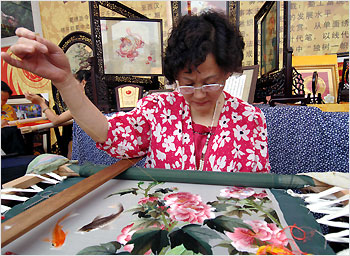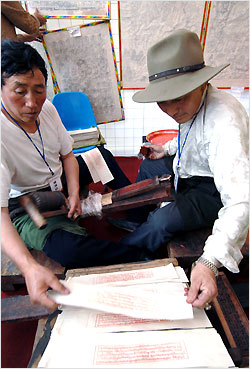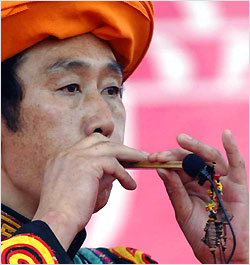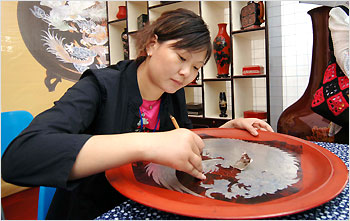| |
The "China Cultural Heritage Day: Chengdu Week" opened on Tuesday. Twenty-seven national intangible cultural heritages were displayed with other folk arts in Chengdu. June 10, 2006 is the first national Cultural Heritage Day in China.
|

Dancers from the Luxian County of Luzhou City, Sichuan Province, perform folk dragon dance in a ceremony to greet the coming China Cultural Heritage Day in Chengdu, capital of southwest China's Sichuan Province, June 6, 2006. As a way to pray for good weather and harvest, the dance was quite popular during the late Ming Dynasty (1368-1644) and the early Qing Dynasty (1616-1911). It is one of the national intangible cultural heritages of China. [Xinhua Photo]
|
|

Hao Shuping, an artist specializing in traditionl Shu embroidery, performs in Chengdu, capital of southwest China's Sichuan Province, June 6, 2006. With a history of more than 2,000 years, Shu embroidery rooted in Sichuan Province is famous for its precise stitch, simple and elegant colors, smooth lines, and a style of traditional Chinese painting. [Xinhua Photo]
|
|

Two technicians from Garse Tibetan Autonomous Prefecture of Sichuan Province perform traditional engraving printing techniques of Tibetans in Chengdu, capital of southwest China's Sichuan Province, June 6, 2006. The technique is one of the national intangible cultural heritages of China. [Xinhua Photo]
|
|

An artist from Aba Tibetan Autonomous Prefecture of Sichuan Province plays Qiang flute in Chengdu, capital of southwest China's Sichuan Province, June 6, 2006. Qiang flute consists of two bamboo pipes bound by strings, which is usually used by Qiang minority living in western China. The performance and production of Qiang flute is one of the national intangible cultural heritages of China. [Xinhua Photo]
|
|

A technician carves on a lacquerwork in Chengdu, capital of southwest China's Sichuan Province, June 6, 2006. Lacquerworks of Chengdu City has a history of more than 3,000 years. The technique of making lacquerworks of Chengdu is listed as is one of the national intangible cultural heritages of China. [Xinhua Photo]
| |
|

